深入研究CIGS(铜、铟、镓、硒)层性质与硅层对提高太阳能电池性能的影响
IF 4.6
3区 材料科学
Q2 MATERIALS SCIENCE, MULTIDISCIPLINARY
引用次数: 0
摘要
利用SCAPS-1D进行了几项研究,以研究太阳能电池器件的性能,主要集中在直流表征的J-V分析上。然而,使用复杂阻抗函数(Z*)和模量(M*)的交流电流(AC)分析揭示了离子传输、重组和扩散等关键过程,这些过程对于优化钙钛矿太阳能电池结构至关重要。这种方法允许确定与每个过程相关联的时间常数(τi)等参数。在这里,我们观察到离子电导率和电子扩散在平衡电荷收集和复合损失中起着关键作用。优化后的结构表明,传统CIGS基电池的功率转换效率(PCE)为16.39%,而CIGS- si基电池的PCE为23.02%。强调了硅层厚度对低频率和高频过程的影响,强调了其对提高太阳能电池效率的重要性。本文章由计算机程序翻译,如有差异,请以英文原文为准。

In-depth study of CIGS (Copper, Indium, Gallium, and Selenium) layer properties with the impact of silicon layer for enhancement of solar cell performance
Several studies using SCAPS-1D have been conducted to investigate the performance of solar cell devices, primarily focusing on J-V analysis for DC characterization. However, alternating current (AC) analysis using complex impedance functions (Z*) and modulus (M*) has revealed critical processes, such as ionic transport, recombination, and diffusion, which are essential for optimizing perovskite solar cell architectures. This approach allows for the determination of parameters like the time constant (τi) associated with each process. Here, we observe that ionic conductivity and electronic diffusion play key roles in balancing charge collection and recombination losses. The optimized structure demonstrates power conversion efficiency (PCE) of 16.39 % for the traditional CIGS based cell whereas the PCE for the CIGS-Si based cell was found to be 23.02 %. The influence of the Si layer thickness on both the low and high-frequency processes was emphasized, highlighting its importance in improving solar cell efficiency.
求助全文
通过发布文献求助,成功后即可免费获取论文全文。
去求助
来源期刊

Materials Science and Engineering: B
工程技术-材料科学:综合
CiteScore
5.60
自引率
2.80%
发文量
481
审稿时长
3.5 months
期刊介绍:
The journal provides an international medium for the publication of theoretical and experimental studies and reviews related to the electronic, electrochemical, ionic, magnetic, optical, and biosensing properties of solid state materials in bulk, thin film and particulate forms. Papers dealing with synthesis, processing, characterization, structure, physical properties and computational aspects of nano-crystalline, crystalline, amorphous and glassy forms of ceramics, semiconductors, layered insertion compounds, low-dimensional compounds and systems, fast-ion conductors, polymers and dielectrics are viewed as suitable for publication. Articles focused on nano-structured aspects of these advanced solid-state materials will also be considered suitable.
 求助内容:
求助内容: 应助结果提醒方式:
应助结果提醒方式:


